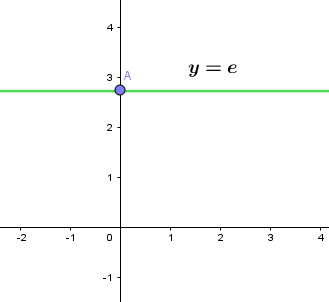
What does $e$ mean in math?
Answer
536.1k+ views
Hint: This type of problem is based on the concept of logarithmic and exponential function. The real number e in mathematics refers to the natural number or Euler’s number. The value of e found by experiment is 2.7182818 approximately. Functions can be defined from the number e which is called exponential function.
Complete step by step solution:
According to the question, we are asked to find what he means in mathematics.
‘e’ is a real number which is called a natural number or Euler’s number.
According to the definition of real numbers, all the rational numbers and irrational numbers are considered to be real numbers.
The value of e found by calculation is 2.7182818……
Here, we find that there are infinite numbers after the decimal. Such numbers are called irrational numbers.
Therefore, e is an irrational number which is a real number.
The approximate value of e is 2.718 which are used for calculation.
According to the definition of exponential function, \[{{e}^{x}}\] is an infinite series, which is
\[{{e}^{x}}=1+\dfrac{x}{1!}+\dfrac{{{x}^{2}}}{2!}+\dfrac{{{x}^{3}}}{3!}+\dfrac{{{x}^{4}}}{4!}+.........\infty \]
Here, the symbol ‘!’ refers to the factorial, that is \[x!=x\left( x-1 \right)\left( x-2 \right).....3.2.1\].
Now, we are asked to find the value of e.
\[\Rightarrow e=1+\dfrac{1}{1!}+\dfrac{{{1}^{2}}}{2!}+\dfrac{{{1}^{3}}}{3!}+\dfrac{{{1}^{4}}}{4!}+.........\infty \]
\[\Rightarrow e=1+\dfrac{1}{1!}+\dfrac{1}{2!}+\dfrac{1}{3!}+\dfrac{1}{4!}+.........\infty \]
On further simplification, we get
e=2. 7182818……
We can plot the graph of y=e.
Therefore, we get

The real number e in logarithmic function plays a different role. If the base of the logarithmic function is e, then the logarithmic function turns to natural logarithm.
That is \[{{\log }_{e}}x=\ln x\].
Note: We can also represent e as \[{{e}^{1}}\].
We know the relation between logarithmic function and exponential function over x.
That is \[\ln \left( {{e}^{x}} \right)=x\].
Here, x=1.
Therefore, we get $ln(e)=1$
Complete step by step solution:
According to the question, we are asked to find what he means in mathematics.
‘e’ is a real number which is called a natural number or Euler’s number.
According to the definition of real numbers, all the rational numbers and irrational numbers are considered to be real numbers.
The value of e found by calculation is 2.7182818……
Here, we find that there are infinite numbers after the decimal. Such numbers are called irrational numbers.
Therefore, e is an irrational number which is a real number.
The approximate value of e is 2.718 which are used for calculation.
According to the definition of exponential function, \[{{e}^{x}}\] is an infinite series, which is
\[{{e}^{x}}=1+\dfrac{x}{1!}+\dfrac{{{x}^{2}}}{2!}+\dfrac{{{x}^{3}}}{3!}+\dfrac{{{x}^{4}}}{4!}+.........\infty \]
Here, the symbol ‘!’ refers to the factorial, that is \[x!=x\left( x-1 \right)\left( x-2 \right).....3.2.1\].
Now, we are asked to find the value of e.
\[\Rightarrow e=1+\dfrac{1}{1!}+\dfrac{{{1}^{2}}}{2!}+\dfrac{{{1}^{3}}}{3!}+\dfrac{{{1}^{4}}}{4!}+.........\infty \]
\[\Rightarrow e=1+\dfrac{1}{1!}+\dfrac{1}{2!}+\dfrac{1}{3!}+\dfrac{1}{4!}+.........\infty \]
On further simplification, we get
e=2. 7182818……
We can plot the graph of y=e.
Therefore, we get

The real number e in logarithmic function plays a different role. If the base of the logarithmic function is e, then the logarithmic function turns to natural logarithm.
That is \[{{\log }_{e}}x=\ln x\].
Note: We can also represent e as \[{{e}^{1}}\].
We know the relation between logarithmic function and exponential function over x.
That is \[\ln \left( {{e}^{x}} \right)=x\].
Here, x=1.
Therefore, we get $ln(e)=1$
Recently Updated Pages
Two men on either side of the cliff 90m height observe class 10 maths CBSE

What happens to glucose which enters nephron along class 10 biology CBSE

Cutting of the Chinese melon means A The business and class 10 social science CBSE

Write a dialogue with at least ten utterances between class 10 english CBSE

Show an aquatic food chain using the following organisms class 10 biology CBSE

A circle is inscribed in an equilateral triangle and class 10 maths CBSE

Trending doubts
Why is there a time difference of about 5 hours between class 10 social science CBSE

Write a letter to the principal requesting him to grant class 10 english CBSE

What is the median of the first 10 natural numbers class 10 maths CBSE

The Equation xxx + 2 is Satisfied when x is Equal to Class 10 Maths

Which of the following does not have a fundamental class 10 physics CBSE

State and prove converse of BPT Basic Proportionality class 10 maths CBSE




